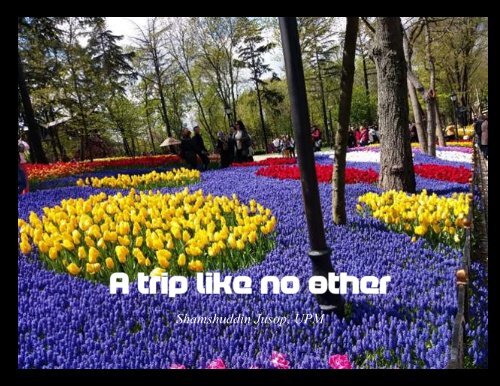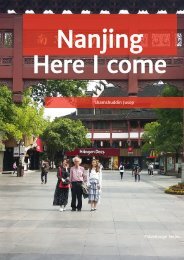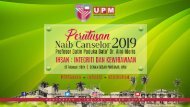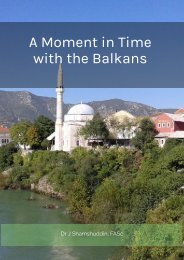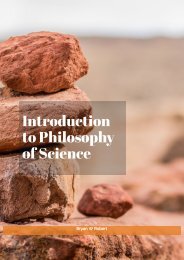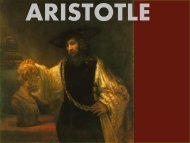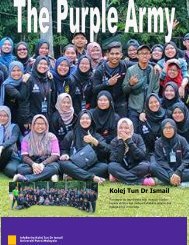Create successful ePaper yourself
Turn your PDF publications into a flip-book with our unique Google optimized e-Paper software.
<strong>Sham</strong>shuddin Jusop, UPM<br />
1
A <strong>trip</strong> like no other<br />
<strong>Sham</strong>shuddin Jusop, UPM<br />
Istanbul Here I come<br />
I took up a break from busy schedule in UPM for a few days to go places with the<br />
loved ones. This time around we headed towards <strong>Turkey</strong>, a country steeped in<br />
history and culture. People often says if you are looking for an adventure or<br />
something different, go to <strong>Turkey</strong> where Roman and Ottoman culture (including<br />
artifacts and/or ruins) are retained at their best to show visitors. Hence, for that very<br />
reason my wife (Fadzilah) and I with my daughter (Syazana) visited that country<br />
on April 13-22, 2019. The photos given below explains it all.<br />
The first day in Istanbul, the business capital of <strong>Turkey</strong><br />
2
With Aiman the tourist guide who took us around in <strong>Turkey</strong> (middle)<br />
A special pose in the street of Istanbul for the album<br />
3
Ladies of substance visiting Istanbul in 2019<br />
4
Sunset in Istanbul is something worth waiting for<br />
5
The sunset in Istanbul is something not to miss by tourists. The above photo was taken after dinner at a floating<br />
Turkish restaurant in Istanbul near the main bridge connecting Asia and Europe.<br />
The quest for Black Tulip<br />
Go to Istanbul and see tulip. That will make you happy and live happily ever after. For all you know, Istanbul<br />
Tulip Festival is held in spring every year. While in <strong>Turkey</strong>, we did not miss the chance to see tulip blooming at<br />
its best in Emirgan Tulip Gardens, Istanbul. For all intents and purposes, it was a dream came true for me. I have<br />
seen tulip before, at a miniature garden in the Netherlands, but it is not the same as seeing it at the place of the<br />
origin, which is <strong>Turkey</strong>. Of particular interest to me then was to see black tulip, a rare species immortalized in<br />
the novel – The Black Tulip - written by Alexandre Dumas. I was glad to spot the some black tulip in the garden.<br />
Thus, mission accomplished, I guess.<br />
Black tulip spotted at the Emirgan Tulip Gardens, Istanbul<br />
6
Other tulip of various shades of colors seen in the Emirgan Tulip Gardens<br />
are shown below. The sights and sounds in the garden was amazing, to say<br />
the least. Tulip in the garden was so beautiful and spectacular, like it was<br />
in heaven – never seen before in any garden I have visited all over the<br />
world, including Malaysia. Men and women from all walks of lives from<br />
the four corners of the globe were there to see tulip in full bloom.<br />
7
8
A photo taken at the end of the tour of the tulip garden<br />
9
The rise of the Ottoman Empire<br />
On the first day in <strong>Turkey</strong>, we spent time to see the legendary Grand Mosque of Bursa, which is one of<br />
the mosques built by the early Ottoman rulers. Constructed in 1396-1399 by Sultan Bayezid I, it is one of<br />
the Islam’s most revered sanctuaries. Located not far the Grand Mosque is the Green Mosque with its<br />
special calligraphic arts painted on the wall. Within a walking distance away is the Tomb of Sultan<br />
Bayezid I. It was from Bursa the then capital of the Ottoman Empire expanded till it captured the strategic<br />
Roman stronghold city of Constantinople, which was later re-named as Istanbul. Many Roman relics are<br />
still there for the eyes of visitors.<br />
Visitors walking towards the Green Mosque in Bursa<br />
10
Spectacular calligraphic writing inside the Grand Mosque of Bursa<br />
11
Colorful decorative wall in the Green Mosque at Bursa<br />
12
A photo taken with fellow travelers at the hotel of accommodation in Bursa<br />
13
Rumi, the Islamic philosopher and thinker<br />
During the <strong>Turkey</strong> <strong>trip</strong> we were brought to Rumi legendary Tomb to see what it was like. Rumi, the founder<br />
of Sufism, was originally from Persia. He was a renowned 13 th Century Islamic scholar, poet and thinker,<br />
respected by both the East and West. Some of his ideas and philosophies are cited by many in the four<br />
corners of the globe even today.<br />
A photo taken before we went to see RUMI Tomb<br />
14
A photo taken in the garden near Rumi Tomb<br />
15
Rumi Tomb has become a big tourist attraction over the years<br />
16
Rumi wrote the first 18 pages of the book on him<br />
17
The Family Tree – depicting a man (top), getting married, having children,<br />
grand children and being left alone again (bottom)<br />
18
After the visit to Rumi’s Tomb was done and over with<br />
19
Mehmed the Conqueror<br />
The fall of the Christian controlled Constantinople into Muslim Ottoman Turks in 1453 was a step forward<br />
for the expansion of Islam into the heartlands of Eastern Europe. The quest to capture the heavily guarded<br />
Roman city was led by Sultan Mehmed Al Fatah, otherwise known as Mehmed the Conqueror. The sights<br />
and sounds of the battle are depicted in movies and books written over the years. They are made to life in<br />
a special museum in Istanbul – Panorama 1453.<br />
Sultan Mehmed was a responsible ruler who made the Ottoman Empire great. He instructed his subjects<br />
to build mosques and others throughout the length and breadth of the country, including Sultan Mehmed<br />
Mosque and the equally fascinating Grand Bazaar during his reign. Constantinople was subsequently re-<br />
20
named as Istanbul with some of the iconic buildings in the ancient Roman city, like churches and others,<br />
converted to mosques and museums that visitors can see today.<br />
The painting of Sultan Mehmed Al Fatah at Panorama 1453<br />
21
Taking a photo with the image of Sultan Mehmed Al Fatah<br />
22
The 1453 battle scenario in Constantinople<br />
23
The victorious Ottoman fighters after the battle was won<br />
24
Sultan Mehmed Mosque with his tomb under the blue dome (left)<br />
25
Enjoying fresh air in the beautiful garden of Sultan Mehmed Mosque<br />
26
The Grand Bazaar of Istanbul<br />
No body miss to be in in Grand Bazaar while in Istanbul. It is the place to get anything you want – from textile to food<br />
to others. Many have fallen in love with its sight and sound. Once you passed through Gate 1 and Gate 7 of the Grand<br />
Bazaar, you leave your heart there.<br />
Gate 7 of the Grand Bazaar in Istanbul<br />
27
Inside the Grand Bazaar in Istanbul near Gate 7<br />
28
Hail to the ladies who loved shopping in the Grand Bazaar<br />
29
A memorable day at Hierapolis<br />
The relics of the Roman Empire is something to talk about while visiting <strong>Turkey</strong>. For many long years,<br />
Anatolia (part of the semi-arid present <strong>Turkey</strong>) was occupied by the Roman. The site shown in the photos<br />
below is the remnant of Hierapolis, a city which was once the playground of the rich and famous or the<br />
royalties when Roman reigned supreme in Anatolia. The ancient Roman city was taken over by the<br />
Ottoman Turks in 15 th Century and later restored/preserved as a national treasure for the country. It is now<br />
remains a popular tourist destination in <strong>Turkey</strong>.<br />
30
The remnant of Hierapolis, a city constructed during the Roman time<br />
An ancient Roman pool being restored for tourists visiting Hierapolis<br />
31
Like the countries in Eastern Europe (e.g. Croatia and Bosnia), <strong>Turkey</strong> is geologically dominated by limestone rocks.<br />
For many days that we have traveling to see places in the country, I could see limestone outcrops everywhere along the<br />
highways. Soils formed on limestone are usually fertile with high pH, without problem of aluminum toxicity. One<br />
particular outcrop of limestone was observed in Hierapolis – this outcrop is mainly made of white calcite (CaCO3).<br />
The white calcite formation as seen from the air<br />
32
Tourists enjoy watching the white calcite formation at Hierapolis<br />
33
34
35
Some calcite dissolves in the running water as seen in the above photo. Then Ca 2+ and CO3 2- precipitates to<br />
produce new calcite crystals forming a spectacular mosaic pattern, amazingly beautiful, to say the least. I felt that<br />
it was hard and sharp which could cause injury if walking on it barefooted. I took the photos shown above myself<br />
during our <strong>trip</strong> to the area.<br />
Flying high on a hot balloon<br />
It cost USD 230 per person to fly in a hot balloon in <strong>Turkey</strong>. This did not deter the visitors from paying that much<br />
money so that they could see the spectacular and beautiful view of Turkish landscape from the air at the day<br />
break. However, I just stayed in the hotel when my wife and daughter took a ride on a hot balloon. I felt that it<br />
was safer and comfortable for me to be at the ground level, leaving me alone to think.<br />
Up in the air in a hot balloon to prove a point<br />
36
A fascinating hot balloon ride by any standard<br />
37
My wife enjoying the hot balloon ride and watching the landscape from the air<br />
38
The spectacular landscape of Cappadocia<br />
A visit to see the spectacular landscape of Cappadocia and the surrounding areas is a good run for the money<br />
spent. This part of <strong>Turkey</strong> is semi-arid and known to have been subjected to violent volcanic activities about 10<br />
- 40 million years ago. During that period of the earth history, volcanic materials (solid, liquid and gases) were<br />
blown off and/or brought to the surface and cooled down or solidified to form ignimbrite with some basalt. It was<br />
heavily rained with volcanic ash towards the end of the volcanic era. The process of weathering and erosion that<br />
followed over the years had resulted in the present landscape seen in the photos below.<br />
In ancient time, people dug pigeon holes in the rocks<br />
39
to collect their droppings to be used as fertilizer<br />
40
The spectacular landscape of Cappadocia Valley<br />
41
The whitish rocks seen in the photo are ignimbrite mixed with weathered volcanic ash, while the reddish one is mineral<br />
hematite (Fe2O3). The yellow and green materials in the weathered rocks are magnesium sulfate and copper sulfate,<br />
respectively. The landscape is simply amazing – having spectacular rocks formation dubbed as “fairy chimneys”.<br />
Another view of the rock formations<br />
42
A day at the Blue Mosque<br />
Tourists come in droves, Muslims or otherwise, to see the great mosque. This, I guess, is one of the most visited mosques<br />
in <strong>Turkey</strong>. Tourists visiting Blue Mosque come from the four corners of the globe. It is located in the old part of Istanbul,<br />
near Tokapi Palace and other equally attractive places to see. The area was lined up with restaurants serving sumptuous<br />
Turkish food.<br />
The world famous Blue Mosque at its best<br />
43
A photo taken after praying in the Blue Mosque<br />
44
The many tourists watching the inside of the mosque - not allowed to go to the praying area<br />
45
The Tokapi Palace<br />
Tokapi is the old palace of the Ottoman Empire – the center of activities when Ottoman rulers reigned supreme.<br />
It was where the reigning Ottoman Sultan lived with all his military and government officials. At any one time<br />
during the height of the empire, about 30,000 people were working in Tokapi Palace to serve the nation and keep<br />
the huge Ottoman Empire going. Tokapi is where some of the rare Islamic artifacts collected from all over the<br />
world are placed for safe keeping – It is called Amanah. Tokapi is within a walking distance away from the Blue<br />
Mosque.<br />
Walking towards Tokapi (in the background is Hagia Sophia)<br />
46
At the gate of Tokapi Palace<br />
47
Outside but not far away from Tokapi is located the Turkish University of Fine Arts. Here students can paint life<br />
models, male or female, for a fee.<br />
Turkish University of Fine Arts<br />
48
Hagia Sophia or Holy Sophia is currently among<br />
the biggest attractions in Istanbul. It is located<br />
outside the Tokapi Palace, but close by. Hagia<br />
Sophia was a Roman church before the fall of<br />
Constantinople to the Ottoman in 1453. It was<br />
converted to a mosque, but later turned into a<br />
museum of antiquity for the people of the world<br />
to see and appreciate. The photos below show it<br />
all how beautiful and attractive Hagia Sophia is.<br />
Visitors appreciating the arts décor inside Hagia Sophia in Istanbul<br />
49
Another view of the iconic Hagia Sophia<br />
50
Intricate painting decorating the main dome of the Hagia Sophia<br />
51
Ayyub Al Ansari Tomb<br />
Al Ansari was a close friend of Prophet Muhammad who brought Islam to Anatolia in 7 th Century. Below is his tomb, which is<br />
located close to Sultan Eyup Mosque.<br />
Al Ansari Tomb is inside the dome<br />
52
Sultan Eyup Mosque is on the right<br />
53
The man who made what <strong>Turkey</strong> is today<br />
In lower secondary school, I was taught the history of the world. The Western educated author of our history book<br />
regarded Mustafa Kamal Ataturk was the Father of Modern <strong>Turkey</strong>. That it is so is also contained in a book by a prominent<br />
US University <strong>Prof</strong>essor of Indian origin (Feroz Ahmad) who has been regarded as an authority on the history of <strong>Turkey</strong>.<br />
The book was printed by a credible publisher in 2014. I also met a prominent Canadian soil scientist of Turkish origin<br />
who mentioned good things about Ataturk. Alas, as far as I know, Ataturk does not have many fans in Malaysia of late.<br />
He was blamed for changing the Syariah compliance country into a secular one in the name of modernization. Well, I<br />
am no judge and I don’t want to take side. Let history judge for whatever he is worth to his country. As a soldier, he won<br />
praise from both friends and foes alike. He won a crucial battle against British Army supported by the secular West that<br />
saved his country from breaking up. Had he lost the battle, part of Northern <strong>Turkey</strong> would have been a Greek territory.<br />
That much I can tell about the contribution of Mustafa Kamal Ataturk to modern <strong>Turkey</strong>. He is now given full military<br />
honor by guarding his mausoleum in Ankara 24 hours a day.<br />
At Mustafa Kamal Ataturk Mausoleum in Ankara<br />
54
The Ataturk Mausoleum in the background<br />
55
My wife and daughter at the Ataturk Mausoleum<br />
56
The Ataturk Mausoleum in the background<br />
57
Turkish flag flying high at the Ataturk Mausoleum<br />
58
Tasting Turkish delights<br />
A visit to the country is not complete without tasting Turkish delights – a bit sweet, but it has been claimed to be good<br />
for health. We therefore visited a Turkish delight outlet in Bursa to prove a point that we did not miss something important<br />
while in <strong>Turkey</strong>.<br />
A picture taken with a shop assistant at a Turkish<br />
delight outlet in Bursa<br />
59
At the <strong>Turkey</strong> Delights Outlet with some of my tour group members<br />
60
What <strong>Turkey</strong> would be like in the future?<br />
Believe me <strong>Turkey</strong> is country to watch in the future. <strong>Turkey</strong> may no longer be strong militarily like it once was, but its<br />
agricultural and textile industries, fashion business and the like are blooming like mushroom coming out after a rainy<br />
day. Kilometers upon kilometers of green fields cropped to olive, grape, apple and others line up the highways across or<br />
throughout the length and breadth of the country. This shows how serious the government is to promote agriculture and<br />
agri-based industries. The soils in <strong>Turkey</strong> are mainly fertile and a large part of the landscapes are flat and suitable for<br />
crop production. Furthermore, agriculture is modern and export-oriented, which make the difference if <strong>Turkey</strong> wants to<br />
remain in business in the long run.<br />
The land in <strong>Turkey</strong> is flat, while the soils are fertile<br />
\<br />
61
This is not to mention about pottery and carpet production to be sold at the marketplace throughout the world.<br />
You pay at the counter and it will be sent to your door step. The quality of its leather products (e.g. jackets) is<br />
second to none in the region, with quality comparable to that of the West (Paris and London or New York).<br />
Tourism in <strong>Turkey</strong> is blooming like nobody business, with people coming in droves from all over the world to<br />
see Roman and Ottoman artifacts, which have been restored and preserved for the eyes of the visitors. All the<br />
afore-mentioned information can be translated into money in hand and economic power. If Malaysia wants to be<br />
in business as an agricultural country in the long run, just emulate the <strong>Turkey</strong> model of developing the country.<br />
Getting ready for the next destination<br />
62
One for the album with all the fellow travelers<br />
63
High quality ceramics and pottery meant for collectors are produced here<br />
64
Leaving the hotel (Hilton Double Tree) in Istanbul<br />
to go home where the heart is<br />
65
66


